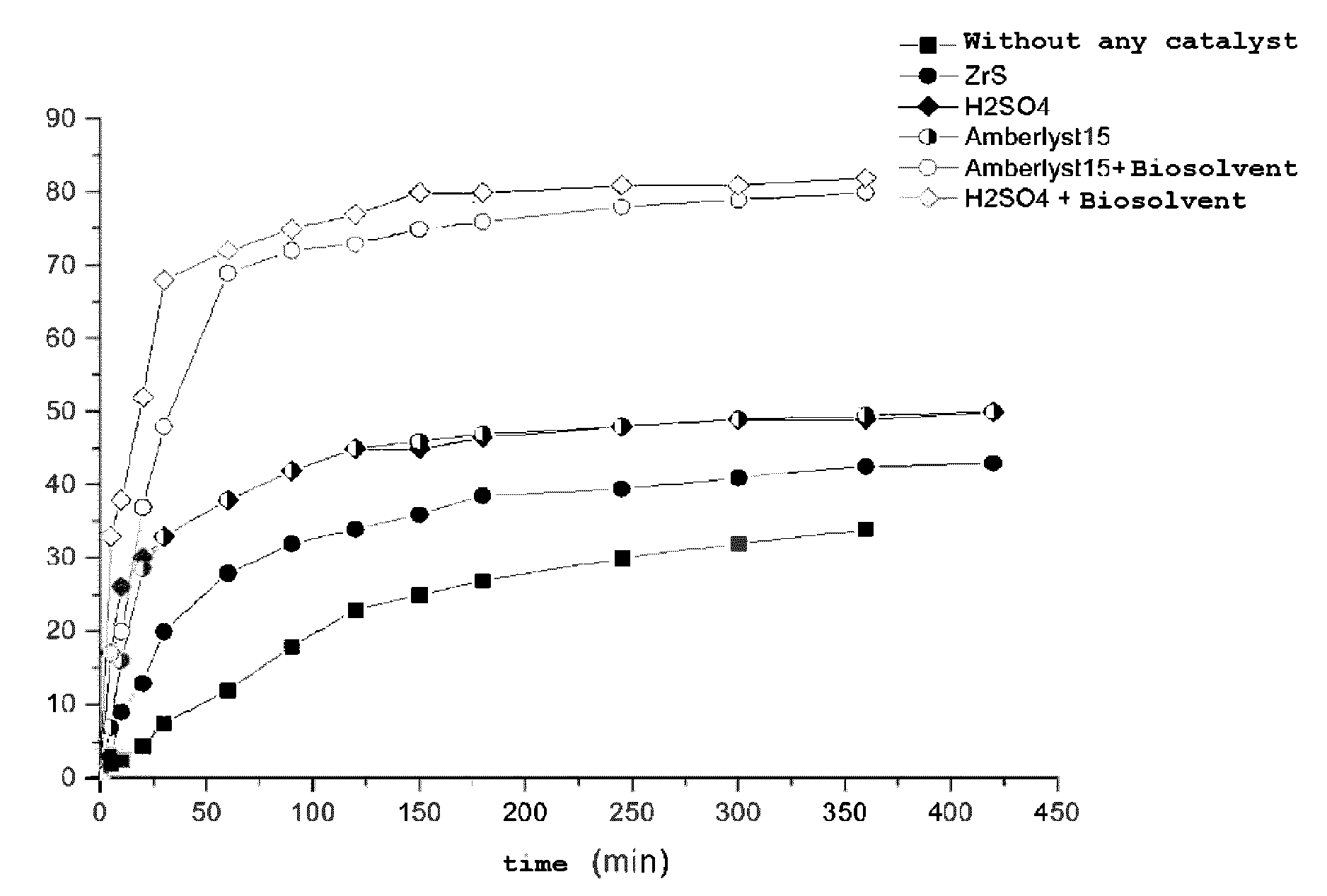Method for obtaining compositions of biosolvents by esterification and obtained compositions of biosolvents
a biosolvent and esterification technology, applied in the field of obtaining compositions of biosolvents by esterification and obtained compositions of biosolvents, can solve the problems of oligomerization of lactic acid, affecting health and environment, and causing a substantial increase in the cost of ethyl lacta
- Summary
- Abstract
- Description
- Claims
- Application Information
AI Technical Summary
Benefits of technology
Problems solved by technology
Method used
Image
Examples
example a
Method Carried Out in the Absence of any Catalyst and of any Organic Biosolvent
[0074]The synthesis of ethyl lactate is achieved in a Pyrex® flask equipped with a condenser.
[0075]The following amounts of reagents are introduced into the reactor: 66.7 g of ethanol, 39.1 g of lactic acid (LA) (EtOH / LA molar ratio=3.3). The reaction medium is stirred by means of a magnetic stirrer. The reaction medium is brought to the reaction temperature by means of a regulated 80° C. oil bath. Progress of the reaction is followed by taking samples. The molar yield of ethyl lactate is determined by gas chromatography (GC) analysis.
[0076]The ethyl lactate yield versus the duration of the reaction is illustrated in FIG. 1, curve a.
example b
Method Carried Out in the Presence of Sulfated Zirconia as a Catalyst and in the Absence of any Organic Biosolvent
[0077]The synthesis of ethyl lactate is carried out in a Pyrex® flask equipped with a condenser.
[0078]The following amounts of reagents are introduced into the reactor: 66.7 g of ethanol, 39.1 g of lactic acid (EtOH / LA molar ratio=3.3). 1.2 g of sulfated zirconia (0.75 mmol of H+), dehydrated beforehand for one night in an oven at 110° C., is added to the reagents. The reaction medium is stirred by means of a magnetic stirrer. The reaction medium is brought to the reaction temperature by means of a regulated 80° C. oil bath. Progress of the reaction is followed by taking samples. The molar ethyl lactate yield is determined by GC analysis.
[0079]The ethyl lactate yield versus the duration of the reaction is illustrated in FIG. 1, curve b.
example c
Method Carried Out in the Presence of Sulfuric Acid as a Catalyst and in the Absence of any Organic Biosolvent
[0080]The synthesis of ethyl lactate is carried out in a Pyrex® flask equipped with a condenser.
[0081]The following amounts of reagents are introduced into the reactor: 66.7 g of ethanol, 39.1 g of lactic acid (EtOH / LA molar ratio=3.3). 0.33 g of 96% sulfuric acid (6.46 mmol of H+), is added to the reagents. The reaction medium is stirred by means of a magnetic stirrer. The reaction medium is brought to the reaction temperature by means of a regulated 80° C. oil bath. Progress of the reaction is followed by taking samples. The molar ethyl lactate yield is determined by GC analysis.
[0082]The ethyl lactate yield versus the duration of the reaction is illustrated in FIG. 1 curve c.
PUM
| Property | Measurement | Unit |
|---|---|---|
| weight ratio | aaaaa | aaaaa |
| weight ratio | aaaaa | aaaaa |
| melting point | aaaaa | aaaaa |
Abstract
Description
Claims
Application Information
 Login to View More
Login to View More - R&D
- Intellectual Property
- Life Sciences
- Materials
- Tech Scout
- Unparalleled Data Quality
- Higher Quality Content
- 60% Fewer Hallucinations
Browse by: Latest US Patents, China's latest patents, Technical Efficacy Thesaurus, Application Domain, Technology Topic, Popular Technical Reports.
© 2025 PatSnap. All rights reserved.Legal|Privacy policy|Modern Slavery Act Transparency Statement|Sitemap|About US| Contact US: help@patsnap.com

